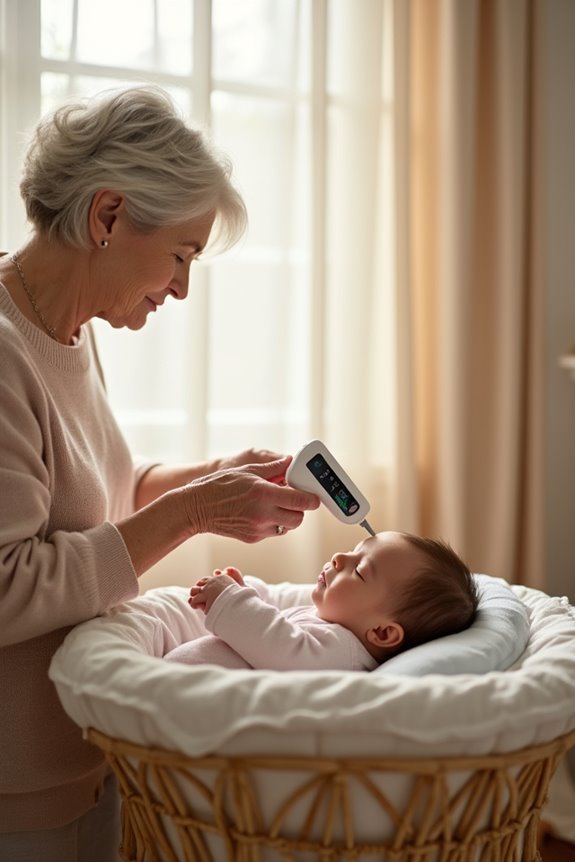The best baby thermometers for newborns prioritize accuracy and speed. Key types include digital thermometers, which provide quick readings and can be used rectally, and infrared models, which offer non-contact convenience. Recommended choices are the Fridababy Quick-Read Rectal Thermometer for its precision, and the Braun ThermoScan7 for its color-coded display. Safety and ease of use are critical; thus, caregivers should guarantee thorough cleaning and designate thermometers for specific use cases. Additional insights await further exploration.
Key Takeaways
- Fridababy Quick-Read Rectal Thermometer offers fast and accurate core temperature readings in just 10 seconds, ideal for newborns.
- Braun ThermoScan7 features a color-coded display for quick fever interpretation, providing results in 10 seconds.
- Kinsa QuickCare Smart Thermometer is versatile with readings in about 8 seconds and is user-friendly for parents.
- Digital thermometers are recommended for newborns, with rectal thermometers being the most accurate for infants under three months.
- Ensure proper hygiene by cleaning thermometers thoroughly before and after use to prevent cross-contamination.
Types of Baby Thermometers
When selecting a thermometer for newborns, it is essential to understand the various types available, as each offers distinct features and benefits.
Digital Thermometers
- Utilize electronic sensors for quick and accurate readings.
- Suitable for oral, rectal, and axillary methods.
- Provide features like memory recall and fever alerts.
- Results are typically available within one minute, balancing speed and precision.
- They are widely available and affordable, highlighting their reliability and ease of use.
Infrared Thermometers
- Use infrared technology for contactless measurement.
- Offer infrared thermometer accuracy from ear or forehead readings.
- Deliver results in about one second, ideal for restless babies.
- Non-invasive and hygienic, they minimize disturbance during use.
Top-Rated Baby Thermometers for Accuracy and Ease of Use
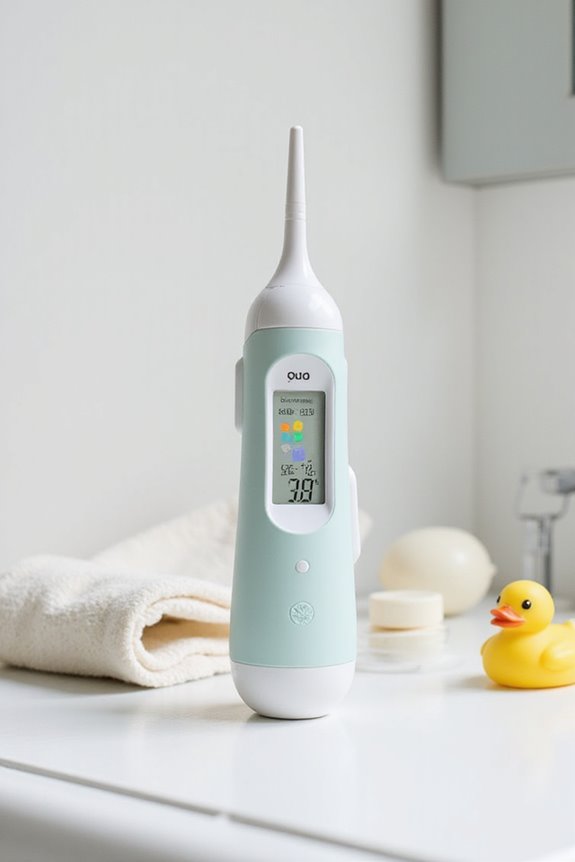
Top-rated baby thermometers combine accuracy and ease of use, critical factors for parents monitoring their newborn’s health.
Key Recommendations:
- Fridababy Quick-Read Rectal Thermometer: Offers readings in 10 seconds, ensuring core temperature accuracy.
- Braun ThermoScan7: Delivers results within 10 seconds and features a color-coded display for quick fever interpretation.
- Kinsa QuickCare Smart Thermometer: Provides readings in about 8 seconds, with multiple usage options to meet parental preferences.
- Vicks SpeedRead: Known for its simplicity and reliability, ideal for families on a budget.
These thermometer recommendations focus on safety, with user-friendly features like back-lit displays and memory functions, facilitating effective monitoring of newborn temperatures.
Key Features to Consider in Baby Thermometers
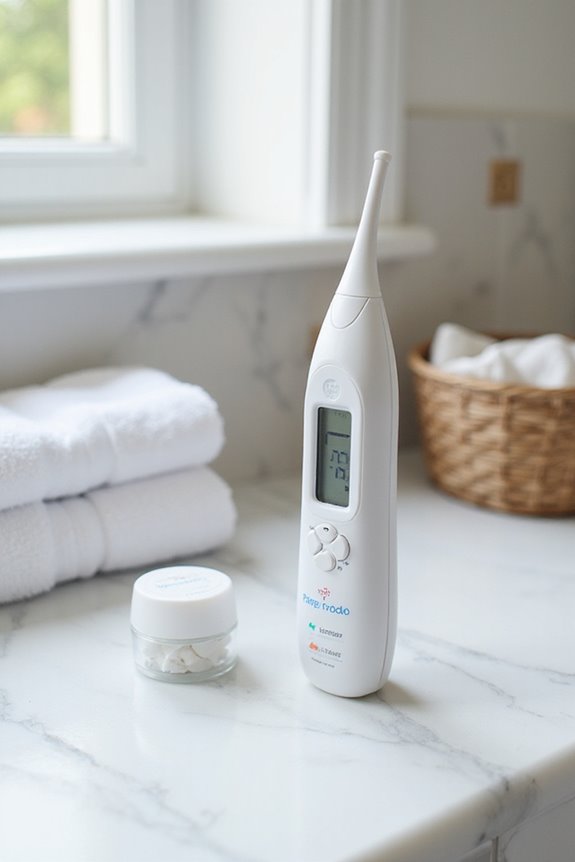
Selecting a baby thermometer requires careful consideration of several key features to guarantee accurate and safe temperature monitoring for newborns.
Thermometer Accuracy
- Rectal thermometers are the gold standard for infants under three months due to their highest accuracy.
- Non-contact infrared thermometers are less accurate but provide convenience.
Digital Features
- Digital readouts enable quick and clear temperature displays, essential for reducing caregiver stress.
- Some models include alerts to indicate when readings are complete.
Ease of Use
- Thermometers with small probes or non-contact designs enhance comfort for newborns.
- Clear labeling for specific use prevents misuse, ensuring hygiene and safety.
Ultimately, choosing a thermometer with these features is critical for effective monitoring and care.
Advantages and Limitations of Different Thermometer Types
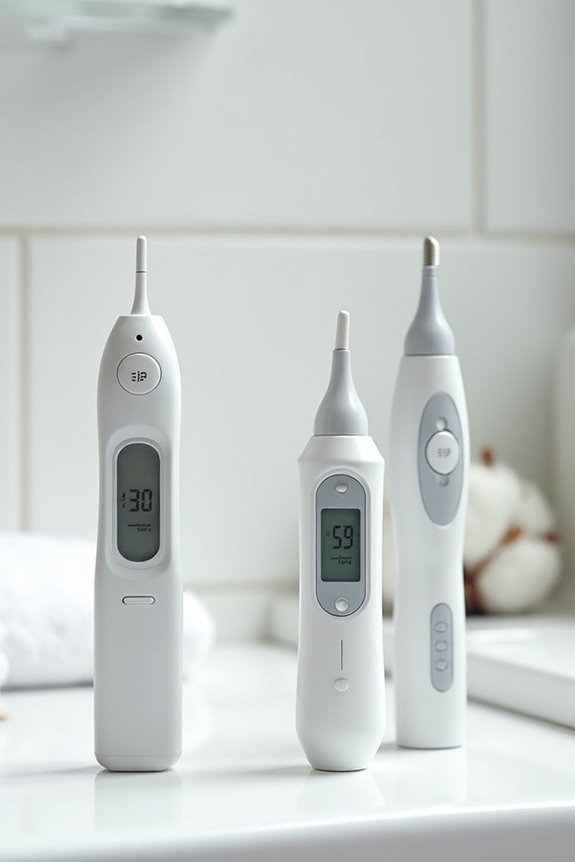
Understanding the advantages and limitations of various thermometer types is essential for effective infant care.
Rectal Thermometers
- Advantages: Most accurate for newborns; provides readings in under 30 seconds.
- Limitations: Requires gentle insertion, may cause discomfort, risk of minor injury, or germ transmission if not sterilized.
Forehead Thermometers
- Advantages: Non-invasive, quick results in 1–3 seconds.
- Limitations: Less accurate than rectal, influenced by sweat and surrounding temperature.
Ear Thermometers
- Advantages: Fast results; less intrusive for older infants.
- Limitations: Not suitable for newborns; accuracy depends on ear canal positioning.
No-Contact Thermometers
- Advantages: Extremely fast and hygienic.
- Limitations: Variable accuracy based on distance and ambient conditions.
These thermometer comparisons highlight essential accuracy factors for caregivers.
Popular Baby Thermometers by Use Case
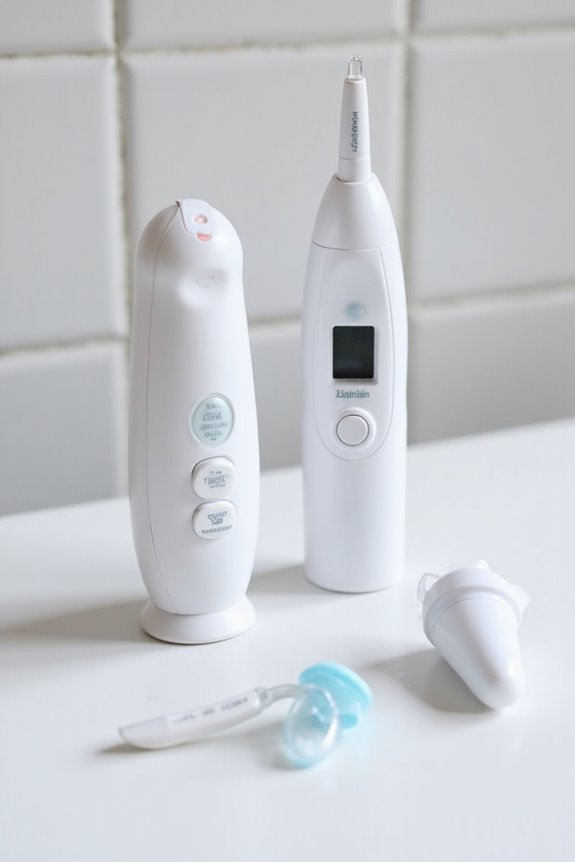
When choosing a thermometer for infants, it is essential to take into account the specific use case and the unique features of each device.
Ear Thermometers
– Braun ThermoScan 7: Offers ear thermometer benefits such as professional-grade accuracy, quick 3-second measurements, and a color-coded display. Suitable for newborns and toddlers.
Rectal Thermometers
– Frida Baby Rectal Thermometer: Known for precision, providing fast readings in 10 seconds, deemed the most accurate for newborns.
Forehead Thermometers
– No-Touch Models: While they allow for non-invasive measurements, forehead thermometer drawbacks include potential inaccuracies compared to core methods. They are easier for parents managing fussy or sleeping babies.
Combo Devices
– iProven Ear and Forehead Thermometer: Combines the benefits of both methods, offering versatility for various situations.
Price Range and Value Considerations
The selection of a baby thermometer involves careful consideration of both price and the features offered.
Price Comparison
Consumer baby thermometers typically range from $10 to $60. Basic models cost around $25, while mid-range options with enhanced features are priced between $30 and $60. High-end models, like the Braun ThermoScan 7, approach $60.
Value Assessment
Accuracy and usability greatly influence the value of a thermometer. Features such as pre-warmed tips, memory functions, and multi-use capabilities enhance diagnostic effectiveness. Budget models under $20 may lack these features, compromising accuracy.
Ultimately, parents must weigh the price against necessary features, considering long-term usability and the reliability of readings for their newborns. A thoughtful investment can guarantee peace of mind during critical health monitoring.
Safety Considerations for Newborns
Safety considerations are paramount when selecting and using thermometers for newborns. Adhering to established safety protocols guarantees accurate and safe temperature readings. For ideal safety, caregivers should:
- Use rectal thermometers specifically designed for newborns, as they provide the most accurate measurements.
- Lubricate the thermometer tip with water-soluble jelly to prevent tissue damage during insertion.
- Clean the thermometer thoroughly with rubbing alcohol or warm soapy water before and after each use to maintain thermometer hygiene.
Additionally, designate a thermometer exclusively for rectal use to avoid cross-contamination. Caregivers must monitor for signs of distress during the process and never leave the baby unattended with the thermometer inserted. These measures are essential for safeguarding the health of newborns during temperature assessments.
How to Use Baby Thermometers Effectively
Effectively using baby thermometers requires a clear understanding of the various types and methods available.
Types of Thermometers
- Digital Thermometers: Accurate and quick, ideal for newborns.
- Rectal Thermometers: Most accurate for infants under three months.
- Temporal Artery Thermometers: Less invasive, suitable for older infants.
- Axillary Thermometers: Easy to use, but less accurate.
Preparation and Maintenance
- Clean thermometers with rubbing alcohol before and after use.
- Use lubricating jelly for rectal thermometers to ease insertion.
Temperature Monitoring
- Verify the baby is comfortable and not overdressed.
- Follow the manufacturer’s instructions for each thermometer type.
- Retake the temperature if readings seem questionable, verifying consistent results.
Tips for Monitoring Your Newborn’s Temperature
Monitoring a newborn’s temperature is essential for ensuring their health, particularly given the heightened vulnerability of this age group. Accurate temperature measurement is vital, as even minor temperature fluctuations can lead to significant health issues.
Monitoring Frequency: New parents should regularly check their newborn’s temperature, especially if any signs of illness arise.
Choosing the Right Thermometer: Utilize digital or rectal thermometers for accurate readings, while being cautious with non-contact infrared thermometers due to potential inconsistencies.
Positioning: Proper positioning of the thermometer is imperative for reliable results.
Continuous Monitoring: Consider devices like the BEMPU TempWatch for ongoing temperature assessment, which facilitates early detection of hypothermia.
Awareness and adherence to healthcare provider guidelines enhance effective temperature monitoring.
Frequently Asked Questions
How Often Should I Check My Newborn’s Temperature?
Temperature monitoring for newborns should occur every 2 to 4 hours if fever symptoms arise. Regular checks are unnecessary without signs of illness, focusing instead on responsiveness and behavior to guarantee ideal care for the infant.
Can I Use an Adult Thermometer for My Baby?
In a softly lit nursery, an anxious parent wonders about adult thermometer safety for their baby. Concerns about thermometer accuracy arise, highlighting the importance of selecting tools specifically designed to guarantee precise and gentle temperature readings for infants.
What Is a Normal Temperature Range for Newborns?
A normal temperature range for newborns is between 96.8°F and 100.3°F. Maintaining this range is crucial for newborn health, as deviations can indicate potential concerns requiring prompt medical attention and careful monitoring by caregivers.
How Do I Clean and Maintain My Baby Thermometer?
To guarantee hygiene and accuracy, one should employ effective cleaning methods, like using soapy water and disinfecting with alcohol. Regular maintenance tips, including routine inspections, enhance the thermometer’s longevity and reliability for families.
What Should I Do if My Baby’s Temperature Is High?
What should one do if a baby exhibits fever signs? Immediate emergency measures include monitoring temperature, guaranteeing comfort, offering fluids, and consulting a healthcare provider, especially for infants under three months, to guarantee their well-being.

